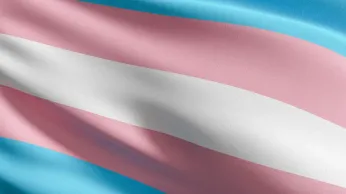
Nov 5
When the Flag Doesn’t Wave: TikTok’s Trans Emoji Glitch and Why It Hits Home
READ TIME: 4 MIN.
If you’ve scrolled TikTok lately, you might’ve noticed something strange: the beloved transgender flag emoji, that staple of queer online affirmation, has stopped showing up in comments for many users. Instead, hopeful posters are met with a barren white flag and a disconnected gender symbol—a technical hiccup, sure, but one that’s left thousands of LGBTQ+ users fuming, confused, and, above all, deeply concerned about what it means when our symbols of pride go missing in action .
It started quietly, as most online phenomena do: a few users noticed the glitch over the weekend, posting screenshots of their comments where the iconic pink, blue, and white stripes should be. Soon, more reports rolled in from across the U.S., the U.K., and Europe—this wasn’t just a local bug or a one-off error. Suddenly, TikTok’s for-you page was ablaze with videos, memes, and no shortage of righteous indignation: Was this a technical fail, or something more sinister?
Alongside the transgender flag, other LGBTQ+ symbols—like the rainbow pride flag and same-gender kiss emojis—were misrendering or breaking, fueling fears of a stealthy crackdown on queer expression. “Just found out that if you try to comment the trans flag emoji on TikTok you get this instead,” tweeted one user, sharing a screenshot of the now-infamous white flag and gender symbol combo . The glitch quickly became a viral symbol in itself—a digital ghost of the community’s flag.
Naturally, the queer online grapevine went into overdrive. Was TikTok, already under scrutiny amid U.S. government buyout rumors, deliberately scrubbing trans visibility from its platform? Was this part of a wider crackdown, or just another example of Big Tech’s indifference to marginalized users?
For many, the timing felt suspect. “A TikTok update from late October promises to combat AI misinformation, make in-app editing easier and censor the trans flag emoji,” noted Queerty, echoing community suspicions . But as the dust settled, tech analysts pointed to a more mundane culprit: Unicode—the behind-the-scenes coding language that tells devices how to display emojis—simply wasn’t playing nice. The transgender flag emoji, unlike some others, is a composite patchwork of a white flag and gender symbol, and not every version of Unicode (or device, or app update) supports the full sequence. The result? A broken emoji, not a broken promise—at least, according to the experts .
“Love and support trans folks but this is 110% a unicode issue,” said one tech-savvy user on X (formerly Twitter), capturing the exasperation and the need for clarity . TikTok itself hasn’t issued a sweeping statement, but did acknowledge to some outlets that it’s “looking into technical issues affecting emoji rendering” . In the meantime, users’ feeds are a patchwork of missing flags and makeshift workarounds.
For those outside the LGBTQ+ bubble, it might be tempting to dismiss the drama as a tech glitch blown out of proportion. But in queer spaces, symbols matter—a lot. The transgender flag emoji is more than just a digital sticker; it’s a badge of pride, a secret handshake, a lifeline to those who need to see themselves reflected in a world that often erases them .
GLAAD, never one to let a visibility issue slide, quickly weighed in: “Any barrier, intentional or not, to trans visibility in large social media spaces is deeply concerning,” the advocacy group stated, urging TikTok to address the issue and ensure the community’s symbols remain accessible and visible . For many, the glitch was a painful reminder of how easily representation can be lost, even by accident. In a post-pandemic world where so much queer life has migrated online, the absence of a single emoji can feel like being silenced all over again.
So what’s a TikTok user to do when the flag won’t wave? The community, as ever, is getting creative. Some have turned to hashtags, alternative icons, or even ASCII art versions of the flag to signal solidarity and keep trans pride visible while the glitch persists . Others are updating their apps and operating systems, hoping a software patch will do what corporate statements haven’t.
Meanwhile, the incident has sparked a wider conversation about the fragility of queer representation in digital spaces. If Unicode standards and tech updates can erase identity symbols overnight, what does that say about who gets to decide which communities are seen, and which are left in the digital shadows? Advocacy groups are calling for tech companies to treat identity emojis, especially those created by marginalized groups, with the same urgency and care as any other feature or bug .
At its heart, the TikTok transgender flag emoji glitch isn’t just about a missing image—it’s about power, presence, and the ongoing struggle for LGBTQ+ visibility in the places where we gather, celebrate, and find each other. As one user put it: “It says, ‘You might not show up the way you expect to.’ Given the role of social media in building community after COVID, that matters.”
The lesson? Queer visibility is never just cosmetic. Even the smallest symbols can be touchstones—tiny but mighty reminders that we belong, that we matter, and that our stories deserve to be told, in pixels or in person.






